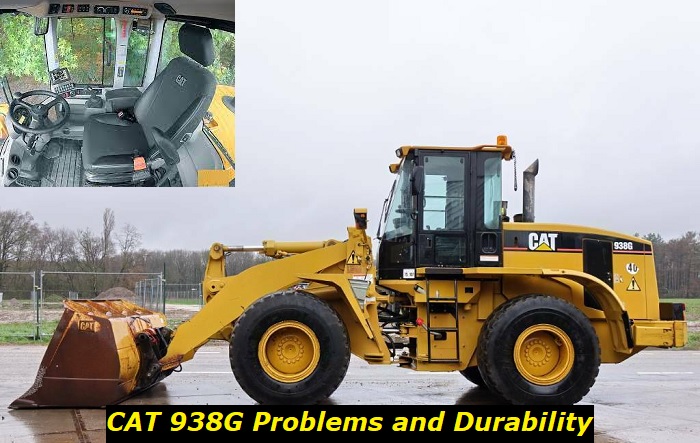CAT 938G: Problems, Durability, and Specs
The CAT 938G was and still remains one of the most phenomenal loaders ever to come off the Caterpillar production house. The loader is capable, efficient and applicable in all manner of job sites. Whether you are looking for the perfect loader for mining works, road construction or farm tasks, the CAT 938G is an option not worth skipping.
In this article, we do a walkaround of the Caterpillar 938G loader. We will explore some of the features that make this machine so popular worldwide. To better understand the loader, we explore the specs that make it capable, reliable and durable. Of course, we cannot end without taking a dive into the main problems that hamper the CAT 938 G's reliability and efficiency.

An Overview of CAT 938G
The CAT 938G is a heavy-duty loader that falls under the G Series from Caterpillar. It was introduced into the market in 1998, and Caterpillar ceased its production in 2003. The loader has been a popular pick by mining companies and road construction companies from all over the world. A 3126B ATAAC engine powers this 13.8-ton loader.
The 938G is a favorite machine for those in the construction industry. Though considerably big, given the heaped bucket capacity of 3.16 yd3, it is a dwarf when put side by side with the CAT 994, which boasts a 23yd3 capacity. Still, this is the loader to check out if you are shopping for a capable yet durable machine. It boasts some cool features that make it a versatile loader to work with in almost any workstation.
The CAT 938G features
- The engine powering the loader is the 3126B, whose power output is 119kW or 160 hp at a rated speed of 2,200 rpm. At 1,800 rpm, the flywheel power is 134 kW 180 hp.
- HEUI fuel system is employed, which, unlike the traditional common rail system, the fuel remains at low pressure until injected into the cylinder. The ECM creates a signal which creates and controls fuel pressure hydraulically. CAT has also equipped the 938G with an advanced diesel engine module (ADEM III), which enables the loader to operate at high altitudes without deration.
- A variable shift control feature allows the operator to select three different shift patterns. In this mode, the loader is still available for full loading, and it helps you save on fuel.
- The integrated braking system of the 938G means better performance and productivity. This feature includes cool tricks such as downhill retarding and self-adjusting transmission neutralization.
- Four-piece axle feature comes with several benefits, among them allowing for the brakes to be serviced without disassembly of the final drive. The brakes are also swathed in oil for optimal cooling and lubrication.
- The 938G has large windows, enhancing the operator's productivity and comfort. The cab affords exceptional ergonomics and storage spaces. A load-sensing steering further serves to improve the loader's capabilities.
- The fuel tank holds a massive 234 litres while the hydraulic system, tank included, holds 90 litres.
- As for your safety, the loader comes with rollover protection structures (ROPS) and a retractable safety belt are present.
- The loader's wheels size is 20.5 x R25, and the maximum ground clearance is 420 mm.
- The rated bucket load capacity is 2.3m3, and the digging depth capability is between 50mm and 64mm.
- The dump clearance at full lift at 45o is discharge ranges from 2,665 to 2,889mm.
- The operating weight of the 938G is between 13,979 kg and 14,191 kg.
- The breakout force is 24,770 pounds (11,236kgs) or 125 kN.
Is the CAT 938G durable?
The CAT 938G loader carries the Caterpillar brand name pretty well. The loader is no longer in production, but you will find it in many mining and road construction sites around the world. When new, the loader is backed by a 24-month warranty. In many instances, a solid warranty serves as a good indicator of the quality of the product. Where the loader has been getting service and maintenance from a CAT specialist, you will still enjoy a warranty when you buy it used.
If the reports from current and previous owners of CAT 938G are anything to go by, this loader is a solid machine guaranteed to serve you for 5,000 hours without developing any serious issues. Some have used the loader for over 10,000 hours and still enjoy working with this machine. It can be universally agreed that CAT 938G is a capable monster, and all that remains is the maintenance and service it accorded.
What are the common problems affecting CAT 938G?
The CAT 938G is an old loader that has likely seen and done all there is for a loader to. By scrolling through the threads in the different online forums, quite a number of owners and users of this loader have encountered problems with it. However, we are going to be objective here. The loader is pretty old, and for problems reported, we will pick those with a higher frequency.
1) The transmission won't move in forward gears
This transmission problem is characterized by the forward gears refusing to engage, yet other gears will engage normally. Once this happens, you will notice the hydraulic pressure dropping to zero in P2. However, the pressure is normal on the gears that are working normally.
This problem will likely happen when the loader has clocked thousands of hours. A leak in the hydraulic system actually causes the problem. This leak causes the forward clutch to fail to engage. The oil pressure drops due to a leak along the piston rings or shaft seals. The leak can also be caused due to excessive wear of the clutch discs and clutch plates. A stuck selector pool will also cause the problem. The answer to the problem would be to rebuild the transmission. This can be costly, time-consuming and a bit tedious. If you can, shop around for a used tranny.
2) Jerking after shifting gear
The problem is characterized by the jerking forward when the reverse gear is engaged after shifting it from the forward gear. The loader will also jerk forward when you shift F-N-F, pause, and start moving forward. Another observation of this problem is the rough gear shifting, which worsens as the transmission fluid gets warmer.
This problem is usually associated with many years of use. The jerking is caused when the flow of oil is impeded. The blocking of the oil flow is likely caused by particles and debris which settle in the oil filter or the screens in the dump valve and control valve. To solve this problem, you will need to remove this debris by pulling apart the transmission and replacing some of the screens, seals and o-rings. Ensure you use the recommended oil and carry out regular loader servicing.
3) Rough gear shifting under load
Some people have reported experiencing rough gear shifting, which can also be characterized by some jerking. This can happen when the system is losing power which can happen through the torque converter. The issue can also be caused when there is a crack in the system which will also cause the oil to be aerated. The solution to the problem can be involving where the transmission might need to be disassembled, and several components will need to be replaced.
4) Brake issues
The brake alarm lights will light up, and you may also experience some braking difficulties. Some owners report finding the accumulators short. The problem can be caused by leaking transmission fluid or a fault with the accumulators. The solution to the problem will involve rebuilding the accumulators and any other malfunctioning parts. Using the correct transmission oil will help you avoid experiencing such issues.
5) The engine won't start
In this case, the engine will crank, but the engine won't start. Several factors can cause this problem. Carry out the basic diagnostics, such as checking the battery or if there is an issue with the wiring. If the problem is more complex, you will need to seek the assistance of a CAT specialist who will check the compression pressure and other factors that can make the engine not start.
6) Engine goes off when hot
In instances where this problem happens, the engine will start alright, and after getting hot and operating, it will stop running. Restarting the engine when hot is impossible until it cools down. Some known reasons why this can happen include an issue with the engine speed or timing, engine shutdown switches, unit injectors or air inlet heater. The fuel supply system and the combustion process in the engine can also cause this problem.
Conclusion
The CAT 938G is a reliable loader that has won accolades over the years. Of course, it has had its fair share of problems to overcome, but when put side by side with other brands of loaders in its class, this loader comes up as a winner. When considering the loader's durability, you must note that the care given to the machine plays a significant role. All in all, the 938G is a loader that rarely disappoints.

Add comment